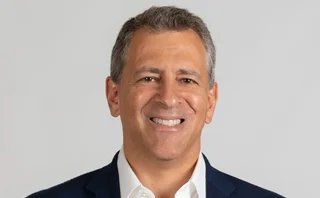
Electricity house of the year: Engie
Energy Risk Awards 2022: Engie’s innovative risk management provides lifeline to clients facing power market turmoil

Very few markets experience the volatility of the electricity market. The almost complete inability to store power, the vulnerability of networks to weather conditions, and hourly swings in demand make whipsawing prices an everyday occurrence.
Yet the level of volatility seen in the electricity markets over the past 18 months – from Storm Uri in the US in February 2021, to the turmoil in the European energy market at the end of 2021 into 2022 – surprised and tested even the most robust electricity market participants.
Engie, winner of the 2022 Energy Risk Electricity house of the year award, stood out during this time for its innovative thinking and unwavering commitment to its customers, says Vincent Verbeke, a member of the executive committee of Engie Global Energy Management and Sales (Gems).
“The key for us is to stay close to our clients,” says Verbeke. “We’ve tried to be flexible, anticipate their needs and, where possible, help clients seize opportunities.”
For example, one of the effects of Uri was to halt the fixed-volume offtake agreements that renewable energy projects had used to hedge intermittent output; after the shutdowns caused by Uri, bankers considered these hedges too risky to write. Without such hedges in place, projects under development could not strike the power purchase agreements (PPAs) needed to secure funding. One such was a 12-year, 80-megawatt (MW) PPA with Savion Energy, underpinning its Brazoria West Solar farm.
However, Gems has developed risk management capacity to manage the intermittency risk associated with so-called as-produced PPAs with renewable energy projects. Engie was able to work with Savion to restructure its fixed-volume PPA into an as-produced contract, ensuring the bankability of the project.
“Absent Engie’s risk management expertise, responsiveness and flexibility, Brazoria West would likely have been another casualty of Uri,” says Kevin Yaich, president of Shikun & Binui USA Energy, which bought the project from Savion. “Instead, Shikun & Binui was able to successfully acquire Brazoria West from Savion.”
In Europe, meanwhile, Gems teams provided clients with “tailored support” during the extreme volatility of the fourth quarter, offering its utility, industrial and reseller clients market access when many of its competitors had stopped pricing. “We stayed with our customers throughout this very challenging period, and we were able to provide them with the right advisory services and innovative solutions to help them tackle this unprecedented situation,” says Verbeke.
It was able to do so because the company had anticipated the potential for market volatility, he adds. “There were some weak signals, before summer 2021, when the post-Covid economy was starting to go full speed ahead. We saw the commodity complex increasing both in terms of price levels and volatility.”
When those trends accelerated towards the end of the year, Engie had credit lines in place with clients and was ready with flexible solutions, he says, including in seizing opportunities created: “For instance, if you see prompt tenors going significantly up, it might be an opportunity for clients to source longer-term tenors.”
Meanwhile, he says, the company’s Egma electronic market access platform enabled it to quote thousands of prices, far in excess of what it could have handled manually. In addition, its online research platform EnergyScan proved popular with clients as they sought access to critical and timely information in a fast-moving market.
The company has also been applying its sophisticated power market risk management capabilities to innovative client structures. One such is the deal it structured with Google, which has a guarantee to provide 80% carbon-free energy. To do so, Engie will pool supply from more than 20 wind energy assets, equivalent to around 70MW, that no longer qualify for subsidies. It will match that supply with Google’s power needs, on an hourly basis.
It also involves a 16-year 41.5MW PPA with a new solar farm, allowing the company to demonstrate its commitment to supporting additional clean energy capacity. In addition, as Google’s power demand increases, additional renewable projects will be added on the go to the current pool of PPAs, allowing both parties to benefit from a global contractual framework.
“This deal is a giant step to accelerate the transition to net-zero emissions,” says Verbeke, “because 24/7 and hourly-based carbon-free supply directly encourages the full-scale transformation of electric grids and increases renewables penetration.”
Gems is also supporting industrial clients with their decarbonisation strategies. Last year, it structured an innovative pan-European 25-year PPA with chemicals giant BASF to supply physical baseload, with the associated Guarantees of Origin to green the supply of a total of 20.7 terrawatt-hours, equivalent to one-quarter of Belgium’s annual power consumption.
“While this is standard for long-term gas contracts, it is exceptional for fixed-price renewable supply,” says Verbeke. “Designing the deal involved careful forecasting of developing renewable energy capacity in the coming decades.” The contract involved unusual flexibility in terms of delivery points as well as bespoke volume delivery. It combines a fixed portion, eliminating BASF’s exposure to intermittency risk, with the right for the company to choose on an annual basis which sites across Europe will receive the power.
“That deal, and others like it, speaks to the overall purpose of the group, which is to act to accelerate the zero-carbon transition”, says Verbeke.
Only users who have a paid subscription or are part of a corporate subscription are able to print or copy content.
To access these options, along with all other subscription benefits, please contact info@risk.net or view our subscription options here: http://subscriptions.risk.net/subscribe
You are currently unable to print this content. Please contact info@risk.net to find out more.
You are currently unable to copy this content. Please contact info@risk.net to find out more.
Copyright Infopro Digital Limited. All rights reserved.
As outlined in our terms and conditions, https://www.infopro-digital.com/terms-and-conditions/subscriptions/ (point 2.4), printing is limited to a single copy.
If you would like to purchase additional rights please email info@risk.net
Copyright Infopro Digital Limited. All rights reserved.
You may share this content using our article tools. As outlined in our terms and conditions, https://www.infopro-digital.com/terms-and-conditions/subscriptions/ (clause 2.4), an Authorised User may only make one copy of the materials for their own personal use. You must also comply with the restrictions in clause 2.5.
If you would like to purchase additional rights please email info@risk.net
More on Commodities
Energy Risk Asia Awards 2025: The winners
Winning firms showcase the value of prudent risk management amid challenging market conditions
Data and analytics firm of the year: LSEG Data & Analytics
Energy Risk Awards 2025: Firm’s vast datasets and unique analytics deliver actionable insights into energy transition trends
OTC trading platform of the year: AEGIS Markets
Energy Risk Awards 2025: Hedging platform enhances offering to support traders and dealers in unpredictable times
Electricity house of the year: Natixis CIB
Energy Risk Awards 2025: Bank launches raft of innovative deals across entire electricity supply chain
Voluntary carbon markets house of the year: SCB Environmental Markets
Energy Risk Awards 2025: Environmental specialist amplifies its commitment to the VCM
Sustainable fuels house of the year: Anew Climate
Energy Risk awards 2025: Environmental firm guides clients through regulatory flux
Weather house of the year: Parameter Climate
Energy Risk Awards 2025: Advisory firm takes unique approach to scale weather derivatives markets
Hedging advisory firm of the year: AEGIS Hedging
Energy Risk Awards 2025: Advisory firm’s advanced tech offers clients enhanced clarity in volatile times







